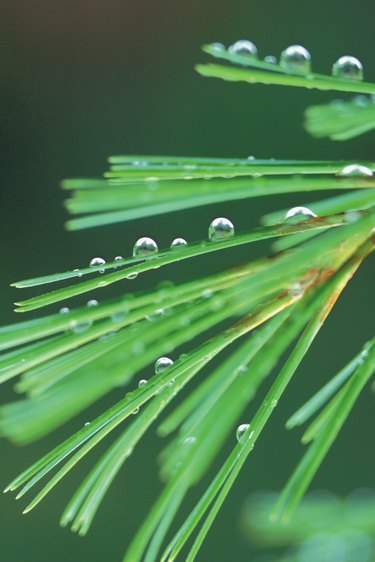
Dried pine needles or pine straw are valuable as organic mulch when used around trees and shrubs and in garden beds to conserve soil moisture, insulate soil and deter weed growth. Pine needles are slow to decompose compared to deciduous tree leaves, which makes pine straw a long-lasting, neat and attractive landscaping mulch. Those same qualities can kill lawns when fallen pine needles are allowed to accumulate.
Leaves on Lawn
Video of the Day
Not just pine needles but even deciduous leaves will damage lawns if allowed to accumulate. Getting leaves off the lawn helps keep turf healthy. A blanket of leaves blocks sun and slows the growth of grass; without sunlight, blades of grass can't photosynthesize as much plant energy. Even more insidious, leaves can collect and hold moisture, creating conditions that promote disease that will cause lasting harm.
Video of the Day
Removing Leaves
Deciduous leaves can be raked, blown or vacuumed -- and in some places it's urgent to do so, such as on golf courses where people need to be able to find that little white ball. Mulching leaves, putting them in the compost pile or using them directly around shrubs, trees and bedding plants, enriches the soil and is much more sensible than hauling them off to landfills. Even simpler, though, is "mulching in place," or mowing the leaves right on the lawn -- chopping and mulching them directly into the turf. Lawn and turf-grass specialists increasingly recommend it. According to University of Virginia Extension, research on this practice suggests "no undesirable effects on turf quality or color, growth, thatch accumulation, soil pH, weed populations or disease pressure."
Removing Needles
Some mowers –- but not all –- can successfully vacuum up pine needles, a hot topic of discussion on various online lawn-mowing forums. But if you don't happen to have one of those mowers, raking is your main option for removing pine needles, because they can't be mowed, chopped and left in place like deciduous leaves. Even if thoroughly chopped, pine needles are very slow to break down; left on the lawn, they remain there for many months. The fierce resistance of pine needles to decomposition is a plus when it comes to landscaping mulch, so pine needles have become a valuable commodity in gardening circles.
Pine-Straw Mulch
Once vacuumed or raked up off the lawn, dried pine needles make long-lasting and attractive mulch perfect for just about any place in your garden but the lawn. Pine straw resists compaction and is easy to work with. Just drop loose dried pine needles by the handful wherever mulch is needed. Intertwined randomly as in nature, pine straw forms a mat that protects vulnerable soil from erosion while allowing water and air to penetrate. When using pine straw or other mulch in the landscape, leave several inches of space around the trunks of trees and shrubs to prevent transmission of pests and disease.